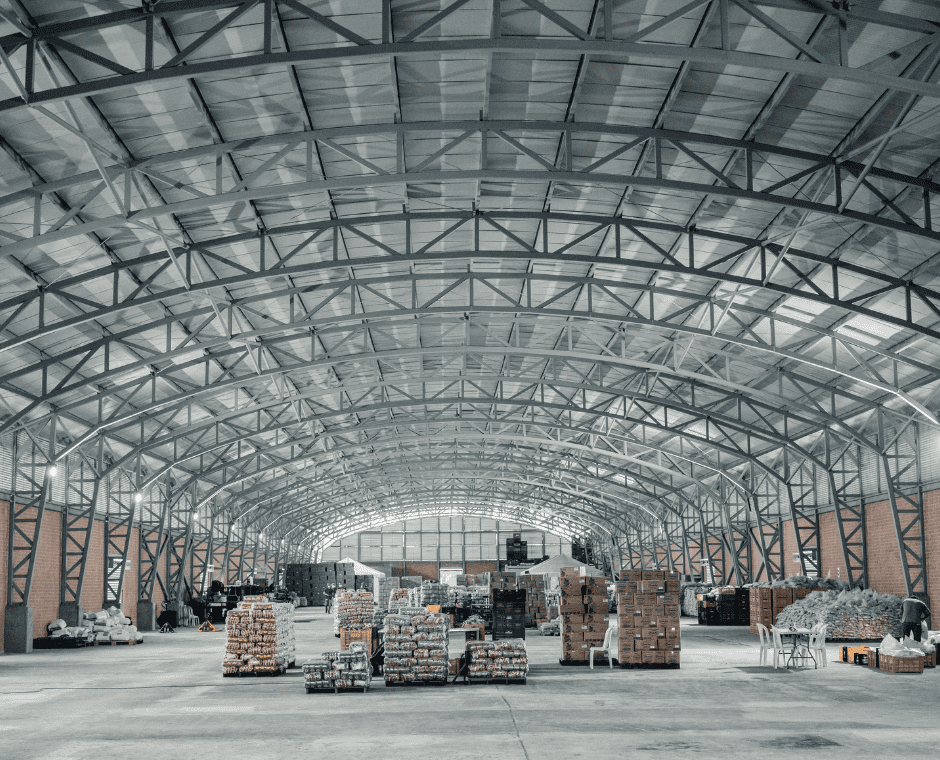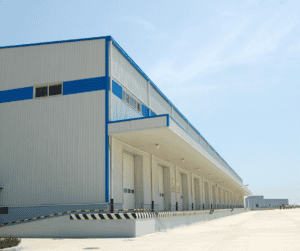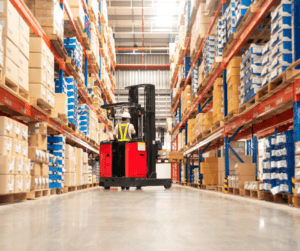Expand Your Business, Not Just Your Space: A Small Business Owner’s Guide to Strategic Growth
- June 19, 2024
- Commercial
Expanding Your Small Business: The Why and How
As a small business owner, the decision to expand your operations can be…
Read More
Warehouse space is the backbone of many businesses. For manufacturers, wholesalers, distributors, ecommerce companies, and more, the warehouse is where inventory is stored, picked, packed, and shipped. Having the right warehouse space can make or break your operations and bottom line.
In this guide, we’ll cover everything you need to know about finding and leasing warehouse space, including:
With the right information and preparation, you can find a warehouse space that aligns with your business needs, supports efficient operations, and sets you up for success. Read on to learn how to navigate the warehouse leasing process.

The internet has made it much easier to find available warehouse spaces for lease without relying solely on brokers. Here are some of the top sites that list warehouse spaces for lease:
For certain industries, there are more niche warehouse listing sites. For example, WineStorage.com focuses specifically on listing temperature-controlled warehouse spaces for wineries. There are similar niche sites for cold storage warehouses and spaces suited for ecommerce fulfillment centers.
Warehouse spaces are typically classified as Class A, Class B, or Class C. This classification system helps tenants understand the general condition and amenities of the warehouse space.
Class A warehouses are top-tier spaces with the newest buildings and the widest range of amenities. Key features of Class A warehouse spaces include:
The advantages of Class A warehouse spaces are the excellent condition of the facilities and the availability of any desired amenities. The downside is that these spaces command the highest rental rates in the market. Class A is best suited for companies that need premier facilities and have the budget to support the higher costs.
Class B warehouse spaces are a mid-range option, with facilities that are older but still functional and well-maintained. Typical features of a Class B warehouse include:
Class B offers reasonably modern facilities at a more affordable rental rate than Class A. These spaces work well for companies that want good functionality without paying a premium for luxury features. The tradeoff versus Class A is that some amenities may be missing or limited in scope.
Class C warehouse spaces provide basic warehouse functionality at the lowest price point. These facilities are older buildings that have limited amenities but offer affordable space. Some characteristics of Class C warehouses are:
The advantage of Class C is clearly the low rental rates. The compromises are that the buildings, systems, and amenities are dated. Class C works best for companies that just need basic warehouse space on a tight budget. But operations may be hampered by the lack of ideal facilities.
When searching for warehouse space, there are several key factors you’ll want to evaluate to ensure the facility fits your business’s needs. Some of the most important considerations include:
Location/Proximity
Think about where your suppliers and customers are located. You’ll want your warehouse to be in relatively close proximity to minimize transportation costs and delivery times. Being near major highways, rail lines or ports can be advantageous depending on your logistics operations.
Loading Docks/Drive-In Access
Look at how many loading docks and drive-in doorways the warehouse has. Having multiple loading bays will make it easier to move inventory in and out efficiently. Some businesses may require drive-in access for unloading directly inside the warehouse.
Power and Lighting
Ensure the warehouse has adequate power capabilities and lighting for your operations. Things like conveyor systems, heavy machinery and computer systems require strong electrical systems. Forklifts need ample lighting to operate safely. Look for warehouses wired for at least 200 amp electrical service.
Ceiling Height
Warehouses should have at least 24-30 feet of clear ceiling height to accommodate pallet racking systems and forklifts. Some operations require taller ceilings for stacking inventory or using cranes for moving materials. Clear height is essential for maximizing storage density.
Other Amenities
Look for modern warehouse facilities offering amenities like sprinklers, air conditioning, loading dock seals and industrial grade flooring. These features enhance safety, comfort and durability for daily operations.
Evaluating factors like location, layout, power and ceiling height will help you find the ideal warehouse for your business’s storage and distribution needs. Prioritize must-have features before signing a lease.

When negotiating a warehouse lease, you’ll want to pay close attention to the lease terms. These will dictate everything from how long you’re committing to the space to how much you’ll pay each month. Here are some of the key lease terms to understand:
Warehouse leases are typically longer term than office leases, often 3-5 years, to account for the larger capital investments required to build out the space. Make sure you negotiate enough time to recoup your investment. You may be able to negotiate a shorter initial term with options to renew.
With a triple net lease, you as the tenant pay a share of the property taxes, insurance, and maintenance costs for the building in addition to rent. This passes on some risk to you but gives you more control. Gross leases fold those costs into the rent, so it’s simpler but you have less control.
It’s common for warehouse lease rates to increase 3-5% annually to account for inflation. Try to negotiate a fixed rate increase rather than leaving it open-ended. You may also be able to negotiate a few months free rent at the start in exchange for accepting the increases. Understand the landlord’s increase rationale before signing.
When negotiating a warehouse lease, you have an opportunity to secure favorable terms and concessions from the landlord. Here are some tips:
With preparation and research, you can negotiate a warehouse lease that meets your business goals and sets up your company for success.
Once you’ve signed your warehouse lease, it’s time to build out the space to meet your business needs. Carefully planning the layout and investing in key improvements upfront will maximize efficiency and operations.
Tenant improvements like racking, lighting, and offices can be a major upfront cost. Be sure to budget appropriately and understand what the landlord covers versus the tenant.
With careful planning and budgeting, you can design a warehouse layout aligned to your business processes and goals. Investing in the right improvements from the start will optimize operations for years to come.

Before signing a warehouse lease, it’s crucial to research the property’s zoning designation and understand any permits you may need for your intended use.
Industrial and warehouse properties are usually zoned as light industrial, heavy industrial, or mixed use. Light industrial zoning allows for manufacturing, processing, assembly, and logistics operations that don’t produce significant noise, traffic, or emissions. Heavy industrial zoning permits more intensive industrial activities. Mixed use zoning allows for a blend of commercial, industrial, and sometimes even residential uses.
Check with your local planning department to verify the zoning for any warehouse space you’re considering. Make sure it allows for your planned operations. You may need to apply for a conditional use permit if your activities don’t precisely match the designated zoning.
In addition to zoning, most warehouse renovations, build-outs, and infrastructure upgrades require permitting. Common permits include:
Submit your plans to the building department early in the process to identify required permits and avoid delays. The leasing agent for the warehouse property can also provide guidance on typical permits for that jurisdiction. With proper zoning and permitting, you can ensure your warehouse space complies with local regulations.
Warehouses provide essential storage and distribution capacity for many types of businesses. Here are some of the key industries that rely on warehouse space:
Manufacturing companies need warehouses to store raw materials, components, and finished products. They require space for receiving, inspection, storage, kitting, order fulfillment, and shipping. Manufacturers often need a significant amount of warehouse space with features like wide loading docks, high ceilings, and material handling equipment.
Distributors act as intermediaries between manufacturers and retailers/end customers. They buy products in bulk from manufacturers and sell smaller quantities to retailers or businesses. Distributors need warehouse space to receive large shipments, break them down into smaller orders, and redistribute. They require space for inventory storage, order processing, packaging, and shipping.
Ecommerce retailers need fulfillment centers to store inventory and process online orders. They require space for receiving stock, picking/packing customer orders, and shipping. As ecommerce sales continue to rise, these companies need more and more warehouse capacity to meet demand. Their facilities are optimized for small, individual orders rather than bulk logistics.
In summary, manufacturing, distribution, and ecommerce companies all rely heavily on warehouse space to store inventory and facilitate order fulfillment. The amount, type, and layout of space depends on the specific inventory volumes and order processing needs. But warehousing is a critical link in the supply chain for these industries.

When searching for warehouse space to lease, it’s important to consider your business’s specific needs and find a space that aligns with your requirements, budget, and future growth plans. Key factors to evaluate include the warehouse location, size, layout, condition, access, and amenities. Be sure to understand common leasing terms like triple net leases, CAM fees, and security deposits before signing a lease.
Negotiating the best deal possible on your warehouse space involves being prepared with information on current market rates and having flexibility on terms like lease length and build-out provisions. Partnering with an experienced real estate broker can provide valuable guidance during the process. Once you’ve secured warehouse space, you can focus on designing and building out the interior to maximize efficiency and meet your operational needs.
With the right preparation and research, you can find an ideal warehouse facility to support your business’s storage, distribution, manufacturing, or other operational needs. The time is now to start your search and claim warehouse space that will enable your company’s growth and success. Reach out to brokers, search online listings, and tour potential spaces today to get the process started. With persistence and patience, you’ll find the perfect warehouse for your needs.
Join The Discussion